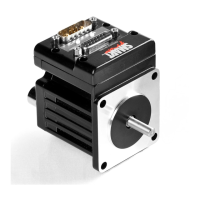Moog Animatics SmartMotor™ Developer's Guide,Rev. L
Page 225 of 909
Class 5 D-Style Motors: Special Functions of I/O Ports
The on-board I/O ports provide the following special functions:
Ports 0 and 1 External encoder (quadrature or step/direction) inputs, brake
output
Ports 2 and 3 Travel limit inputs, brake output
Ports 4 and 5 Communications, brake output
Port 6 Go function, capture input, brake output
NOTE: The brake output function can be pointed to any one of the on-board I/O or
expanded I/O ports.
I/O Ports 0 and 1 – External Encoder Function Commands
Ports 0 and 1 can be wired to a external encoder. Below are the supporting configuration
commands:
NOTE: For proper counting, the commands OS(), OR() and OUT() should be
avoided for ports 0 and 1.
MF0 Set encoder counter to zero; put it in Quadrature Count mode
MS0 Set encoder counter to zero; put it in Step and Direction Count
mode (default count mode)
I/O Ports 2 and 3 – Travel Limit Inputs
Ports 2 and 3 are defaulted to travel limit inputs. They can be changed to a general-purpose
I/O points by using the EIGN() commands and then returned to the travel limit function with
the following commands:
EILN Set I/O 3 as negative overtravel limit
EILP Set I/O 2 as positive overtravel limit
I/O Ports 4 and 5 – Communications
Ports 4 and 5 can be configured as a second communications channel. Channel 0 is the main
communications channel. Ports 4 and 5 are associated with commands for communications
across channel 1. For more details on communications, see Communication Details on page
93.
Modbus and DMX protocols are additional communications options that can be used instead of
RS4. For more details on these optional protocols, see the documentation for the specified
protocol. The communication protocol is specified with the OCHNcommand type parameter.
For details, see OCHN(type,channel,parity,bit rate,stop bits,data bits,mode,timeout) on page
101.
Part 1: Programming: Class 5 D-Style Motors: Special Functions of I/O Ports

